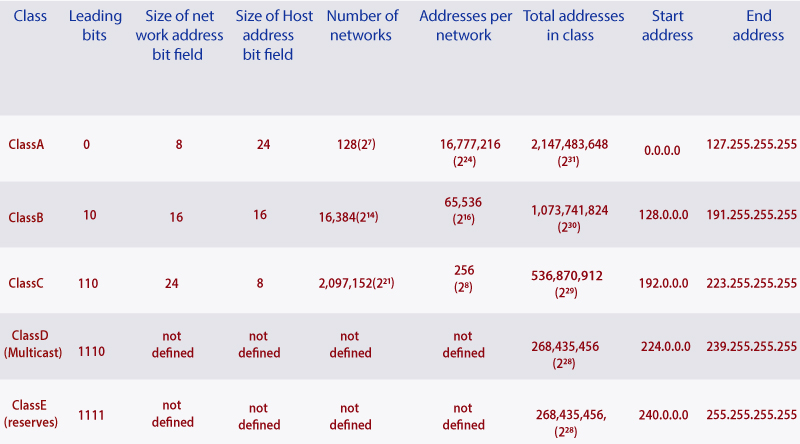Classes of IP Addresses
Classes of IP Addresses
There are following five classes of IP Addresses:
- Class A – It is used for allocating an IP address.
- Class B - It is used for allocating an IP address.
- Class C – It is used for allocating an IP address.
- Class D – It is used for multicasting.
- Class E – It is reserved for experimental use.
Class A Network Addresses
In Class A network address, the one byte (8-bits) is assigned to the network address, and the remaining three bytes are used for host addresses.
The class A address format is as follows:
Network.Host.Host.Host
0NNNNNNN.HHHHHHHH.HHHHHHHH.HHHHHHH
Where –
0 = Leading bit.
It is fixed and used to identify class A network.
N = Network Address
H = Host Address
Class A network address range:
00000000 = 0
01111111 = 127
- Total number of addresses in class A is 231
- Class A address has 1 byte (8-bits) for the network address, where 0 is fixed by default, and remaining 7 bits are used to represent network address.
Therefore, some unique network addresses in class A are 27 = 128.
- Class A address has 3 bytes (24-bits) for the host address.
Therefore, the number of unique Host addresses in class A 224 = = (16777216).
- Number of valid Networks addresses in class A = 27-2
= 128-2
= 126
Range of valid network addresses in class A are1.0.0.1 to 126.255.255.254.
- Number of valid Host addresses in class A = 224-2
= 16777216-2
= 16777214
Range of valid host addresses in class A are 10.0.0.1 to 10.255.255.254.
Note: We have subtracted 2 because the first byte of network address (all 0s) is reserved for the default route, and last byte address (all 1s) is reserved for loopback and broadcast address. We cannot assign the first and last address to any user.
Class B Network Addresses
In Class B network address, the first 2 bytes (16-bits) are assigned to the network address, and the remaining 2 bytes (16-bits) are assigned to host address.
The class B address format is as follows:
Network.Network.Host.Host
10NNNNNN.NNNNNNNN.HHHHHHHH.HHHHHHHH
Where –
10 = Leading bit
It is fixed and used to identify the class B network.
N = Network Address
H = Host Address
Class B Address Range:
10000000 = 128
10111111 = 191
- Total number of addresses in class B are 230
- Class B address has 2 bytes (16-bits) for the network address, where 10 is fixed by default, and remaining bits used for the network address.
- Therefore, the number of unique network addresses in class B are 214 = 16,384 .
- Class B address has 2 bytes (16-bits) for the host address.
- Therefore, the number of unique host addresses in class B are 216 = 65,536.
- Number of valid Network addresses in class A = 214 -2
= 16,384-2
= 16,382
- Range of valid network addresses in class B are 128.1.0.1 to 191.255.255.254.
- Number of valid Host in class B= 224 -2
= 65,536-2
= 65,534
- Range of valid host addresses in class B are 172.16.0.1 to 172.16.255.254.
Class C Network Addresses
In Class C network address, the first 3 bytes are assigned to the network address, and the remaining 1 byte is used for the host address.
The class C address format is as follows:
Network.Network.Network.Host
110NNNNN.NNNNNNNN.NNNNNNNN.HHHHHHHH
Where –
110 = Leading bit
N = Network Address
H = Host Address
Class C Address Range
11000000 = 192
11011111 = 223
- Total number of addresses in class C is 229
- Class A address has 3 bytes (24-bits) for the network address, where 110 is fixed by default, and remaining bits used for the network address.
Therefore, the number of unique network addresses in class C is 221 = 2,097,152.
- Class C address has 1 byte (8-bits) for the host address.
Therefore, the number of unique host addresses in class C is
28= 256
- Number of valid Networks in class C= 221 -2
= 16,384-2
= 16,382
- Range of valid network addresses in class C are 192.0.1.1 to 223.255.254.254
- Number of valid Host addresses in class C= 28-2
= 256-2
= 254
- Range of valid host addressesin class C are 192.168.100.1 to 192.168.100.254
Class D Network Addresses
- Class D network address begins with binary 1110, which is fixed for identifying the Class D network.
- The range of Class D network is 224 to 239.
- Class D address is used for multicast addresses.
Class E Network Address
- Class E network address begins with binary 1111, which is fixed for identifying the Class E network.
- The range of class E network is 240 to 255.
- Class E network addresses are reserved for experimental use.
Reserved IP Addresses:
There are some reserved IP addresses, which are given below:
- The network address of all 0s.
- The network address of all 1s.
- Network 127.0.0.1
- Node address of all 0s.
- Node address of all 1s.
- Entire IP address set to all 0s, i.e. 0.0.0.0.
- Entire IP address set to all 1s, i.e., 255.255.255.255.
We can summarize all the classes of IP addresses in the below table:
